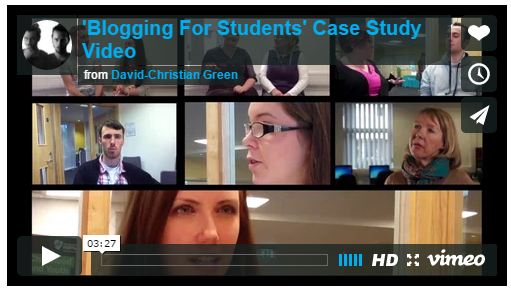Teaching Students at University of Northampton, along with Helen Caldwell (Senior Lecturer in Education) describe how well and how effectively they feel blogging has become a way to record and assess their work.
A short film edited together for Northampton University School of Education.
To watch the video, please click the image below:
In this podcast, Jean Edwards (Senior Lecturer in Education) talks to Jim Harris (Learning Designer) about the module PDT3003 Educational Debates in Learning and Teaching, part of the BA Learning and Teaching, which includes assessed Online Debates using discussion boards in NILE
Please click below to listen to the podcast (duration: 07:32).

In this podcast, Jim Harris (Learning Designer) speaks to Jean Edwards (Senior Lecturer in Education) about the project which aims to investigate the use of mobile technologies in innovative assessment design and guidance, broadening the range of assessment practice to enhance tutors’ and students’ digital literacy.
The objectives of the project are:
- To map the current use of mobile technologies in assessment by staff and explore student perceptions.
- To explore and evaluate three case studies of digitally based assignments across the School of Education.
- To design a digital toolkit to support staff in devising assignments and assignment guidance.
Please click below to listen to the podcast (duration: 07:45).

To find out more about the project, please visit the project website by clicking here.
The Science and Technology in Pedagogy (STRiPe) Research Group was set up to facilitate those working on teaching and learning activities related to science and technology to collaborate. Pedagogy is central to the success of the University, and having a cross-disciplinary and cross-university groups aims to help with this. STRiPe’s aims to take the work members are doing or planning to do with their students, and help with collaboration.
For information about the group, please see the page on the main University website.
Please click this link to access the blog maintained by School of Science and Technology.
In this associated blog post, Matthew Mccormack details the team approach to the redesign of the MA History, and how the use blogs aligned to evidence one of the key subject benchmark statements.
“Our blog assessment fits in with the module’s fortnightly structure. We alternate between ‘classroom’ and ‘online’, with the blog taking place alongside the online seminar: case studies have emphasised the importance of structuring blogging around the rhythm of classes. Every fortnight, the tutor posts up a primary source that relates to the previous class topic, and the students have 500 words per source to blog about it. After 5 fortnightly blogs, the students submit their work for assessment…One of the key ‘History’ skills highlighted in our subject benchmark is ‘an ability to read, analyse and reflect critically and contextually upon contemporary texts and other primary sources’ – so this is an example of how blending the method of delivery can enhance subject skills.”
I used to teach Contextual Studies at the Carmarthenshire School of the Arts. I found a fairly simple way to utilise TEL (Technology Enhanced Learning) through working with Pinterest* as a 21st century equivalent of a visual diary/reflective journal/ sketchbook. In a Level 4 Visual and Material Culture module for Contextual Studies I teamed up with the tutors leading practical modules to create a joint task. Each tutor (theoretical and practical) set up a Pinterest account that demonstrated their aesthetic interests.
Stage one of the tasks was that students reviewed staff sites in order to identify contemporary trends and to evaluate the components of each staff member’s aesthetic (formal elements such as colour palette and conceptual concerns).
Stage two was to create their own boards relating to their own concerns and at least two elements from the lecture programme. The title function on the image can be used to capture short, critical and reflective writing on their selections.
Throughout the module students were expected to share pins and form a ‘visual dialogue’ with each other. They also had to write a short reflection on the development of their aesthetic across the term. The boards, pins, notes, visual dialogue and reflective account then became part of their assessment at the end of the module*1
What is nice about Pinterest is that you can Pin any 2D or moving image so I have also used this in an education context because you can create snapshots of texts, review books, share video case studies etc and comment on them.
*Please note that Pinterest is not a University supported tool and so no targetted staff development training is available. However, it has an extremely user friendly interface and is easy to self-teach.
*1 Due to the fact that Pinterest is an external provider you cannot put students in a position where they would be disadvantaged if they did not use it. My way round this was to allow alternative modes of responding to the task (e.g. the more traditional sketchbook or reflective journal)
Undergraduates on the Film and Screen Studies degree course are now enjoying seminars and screenings at the Errol Flynn Filmhouse, in Northampton, allowing them to see movies as directors intended – on the giant screen.
“This is an exciting opportunity for students, enabling them to study films within the environment of their reception, while also providing them with an invaluable insight into industry practices,” said Dr Michael Starr, Lecturer in Film and Screen Studies.
Watch the film here: Errol Flynn Cinema screenings for UN students as part of Film and Screen Studies Lectures
Source: University of Northampton. 2015. University of Northampton students get their lecture kicks at the flicks. [ONLINE] Available at: http://www.northampton.ac.uk/news/university-of-northampton-students-get-their-lecture-kicks-at-the-flicks. [Accessed 30 November 15].
[Posted on behalf of Elizabeth Palmer]
When starting to make online activities for blended learning there is a temptation to take content that is currently being delivered face-to-face in lectures (through software such as Powerpoint) and moving that content into an online format where the students are ‘digitally page turning’ through material: read or watch x, y and z before class.
The learning and teaching plan for blended learning is that we are creating interactive activities that support students towards developing their own knowledge, understanding and creating outputs that can then be used in class. In other words we are trying to flip the focus away from tutor created content that the student must passively absorb, to student-led interactive and created content.
Any content provided to students should be done in an interactive, discovery based way i.e. rather than telling them the answer we allow them to discover the answer through questioning, testing, trialling, problem solving etc. online and then reinforce and develop this face to face. If you are trying out e-tivities for the first time Xerte can be a useful package to start this process. Have a look at these two examples of using Xerte to make interactive activities on academic skills: here and here. Whilst they are not necessarily perfect, they demonstrate how you can use Xerte’s functionality to create knowledge checking, interactive exercises that you could then build on in class or use as a basis for students to undertake a more complex task.
The following presentation by Dr. Rachel Maunder entitled “Watering down Waterside” provides a summary of a similar presentation delivered at the School of Social Sciences Learning and Teaching event in February 2016.
Incorporating the Institute of Learning and Teaching’s (ILT) Direction of Travel video, the presentation provides advice and strategies for programme teams when thinking about the design of their modules and programmes for delivery now, and in preparation for Waterside, linking the use of NILE and the NILE benchmarks, describing blended learning and flipped learning approaches (with examples such as the module PSY1006 – Becoming a Psychologist), and introducing elements of the CAIeRO process.
At the recent Sharing Higher Education Design (S.H.E.D.) roadshow week in Science and Technology, the Learning Design team were introduced to a number of examples of good practice, including the hugely successful open educational resources (OERs) that have been published by staff in the School. These resources – some of which have had hits in the thousands – are publicly available, benefiting not just our students but learners around the world who are looking to further their understanding.
To find about more about these resources, visit the Learning and Teaching blog from the School.
Watch this space for more case studies from the S.H.E.D!
Recent Posts
- Blackboard Upgrade – December 2025
- Preparing for your Physiotherapy Apprenticeship Programme (PREP-PAP) by Fiona Barrett and Anna Smith
- Blackboard Upgrade – November 2025
- Fix Your Content Day 2025
- Blackboard Upgrade – October 2025
- Blackboard Upgrade – September 2025
- The potential student benefits of staying engaged with learning and teaching material
- LearnTech Symposium 2025
- Blackboard Upgrade – August 2025
- H5P (HTML5 package) content types meets the needs of Jim Atkinson, Staff Development Trainer
Tags
ABL Practitioner Stories Academic Skills Accessibility Active Blended Learning (ABL) ADE AI Artificial Intelligence Assessment Design Assessment Tools Blackboard Blackboard Learn Blackboard Upgrade Blended Learning Blogs CAIeRO Collaborate Collaboration Distance Learning Feedback FHES Flipped Learning iNorthampton iPad Kaltura Learner Experience MALT Mobile Newsletter NILE NILE Ultra Outside the box Panopto Presentations Quality Reflection SHED Submitting and Grading Electronically (SaGE) Turnitin Ultra Ultra Upgrade Update Updates Video Waterside XerteArchives
Site Admin



